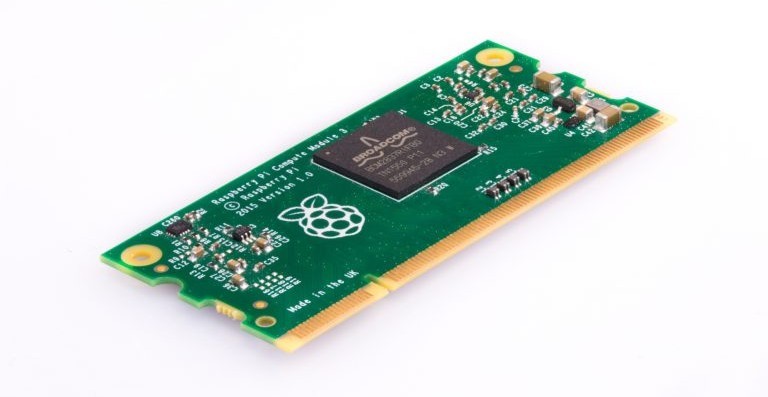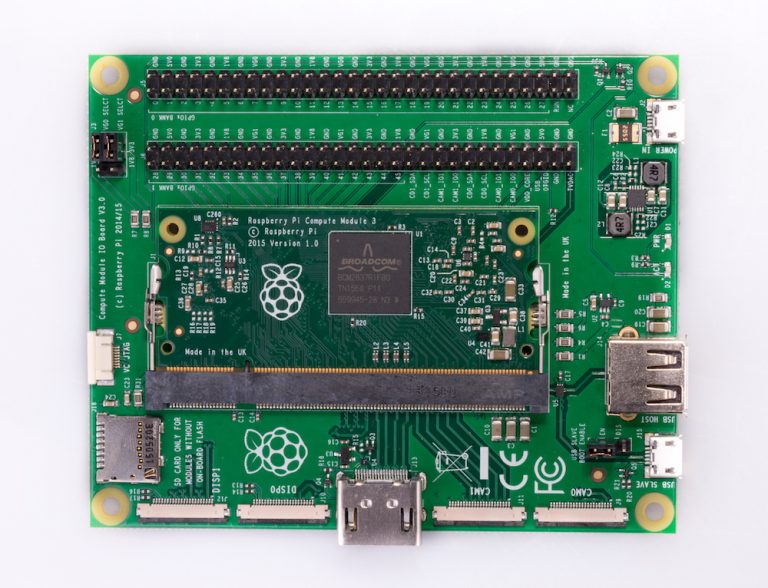Raspberry Pi Compute Module 3 released with ten times more performance

Compute Module 3
In April 2014, the Raspberry Pi Foundation released the first version of the Compute Module (CM1) computing module . It was based on the BCM2835 processor of the original Raspberry Pi mini-computer. With the same processor, this board was much smaller in size: about the same as the RAM strip for a laptop. Actually, the module is made exactly in the form factor DDR2 SODIMM for a laptop. All connectors and a contact pad disappeared on the board, only the processor, ROM and RAM remained.
Almost three years have passed since the release of the original model. During this time, the light saw another two generations of the Raspberry Pi, each time increasing performance. So now is the time to upgrade the compute module: we meet Compute Module 3 , backward compatible with CM1.
Initially it was assumed that with the help of such a “compute module” and expansion cards, third-party developers can create more functional systems than the Raspberry Pi itself, almost full-fledged PCs. Or vice versa, it can be used in devices where the functionality and dimensions of the Raspberry Pi are superfluous. In general, in the development of any non-standard products.
')
Compute Module has received deserved recognition and popularity. It was used to develop a variety of devices, including the Internet of things and industrial robots. The computing module was even sent into space as part of the miniature CubeSat satellites. Small, cheap computers have proven to work reliably under irradiation with cosmic radiation. Under the control of CM1, the satellites successfully coped with the task of finding each other and performed various maneuvers, including collision avoidance and docking. For maneuvers used lidars or sensors Microsoft Kinect.

The structure of the microsatellite MirrorSat
Compute Module 3 is based on the hardware of the Raspberry Pi 3. It has twice the RAM and about ten times more performance than the original module.
Total released two versions of Compute Module 3: standard and lightweight.
Standard CM3
Processor: BCM2837 clocked at up to 1.2 GHz
RAM: 1 GB
Flash memory: 4 GB eMMC (built-in)
Lightweight CM3L
Processor: BCM2837 clocked at up to 1.2 GHz
RAM: 1 GB
Flash memory: interface for SD cards
As you can see, the light version differs only in the absence of flash memory on the module. But the interface remains, so SD or eMMC can be connected if necessary. The photo shows the reverse side of both modules: on the left is a standard CM3, on the right - CM3L (Light).

Among the first Compute Module 3 applied in their products is the company NEC, which used it in widescreen displays of the new generation. Such displays with a diagonal of up to 96 "are intended for use in public places: schools, offices, shops, train stations, etc.

Compute Module 3 in the NEC display
This is just one example of the industrial use of the CM3. Computing modules will surely find application in other areas, as well as modules of the first generation CM1, hope in the Raspberri Pi Foundation. Any group of enthusiasts in the garage can use the same technology that is available to a large corporation such as NEC. At the same time, they do not need to bother with technical details like pinout of the processor or high-speed memory interface, power supply of the computer. When connected to a simple expansion card, all external interfaces work out of the box. The module uses the standard form factor of RAM for a DDR2 SODIMM laptop, such connectors are supported by several manufacturers, they are inexpensive and easily accessible.
CM3 is almost identical in size to CM1, it is only 1 mm higher. The connector is the same. From a hardware point of view, the difference is only in the higher power consumption of the processor (VBAT). With a large load, it is very hot.

By tradition, along with the module, reference extensions are also presented, rather for demonstration and educational purposes. It is probably convenient to use such boards for experimenting with the CM3 before designing and releasing your own board.

The Compute Module IO Board V3 (CMIO3) board provides the module with the necessary power and allows you to program flash memory (in the standard version) or use SD cards (in a lightweight), gives easier access to the processor interfaces (pin header and connectors, as in RPi). There are HDMI and USB interfaces.
The reference board CMIO3 is compatible with the first generation modules, as well as with the new CM3 and CM3L.
Full technical information and CM3 published in the documentation section :
- Specs
- Flowcharts
- CMIO design files and camera / display expansion cards
- Design Guide for Compute Module
- Overwriting eMMC internal flash memory using Compute Module IO Board
- Connection of peripheral devices to the computing module
- Camera connection Raspberry Pi
- Connecting the official 7-inch display
Price
CM3 and CM3L are sold for $ 30 and $ 25, respectively (excluding tax and delivery). The price is valid for both retail and wholesale purchases.
At the same time, the cost of the first CM is also reduced to $ 25. For some tasks, reduced power consumption may be more important than power, so CM1 will find a buyer.
RS affiliate stores and Premier Farnell offer complete developer kits that include everything you need to get started with Compute Module 3.
element14
RS Components
An expansion card is sold separately for £ 96 (approximately $ 116).
Source: https://habr.com/ru/post/400677/
All Articles